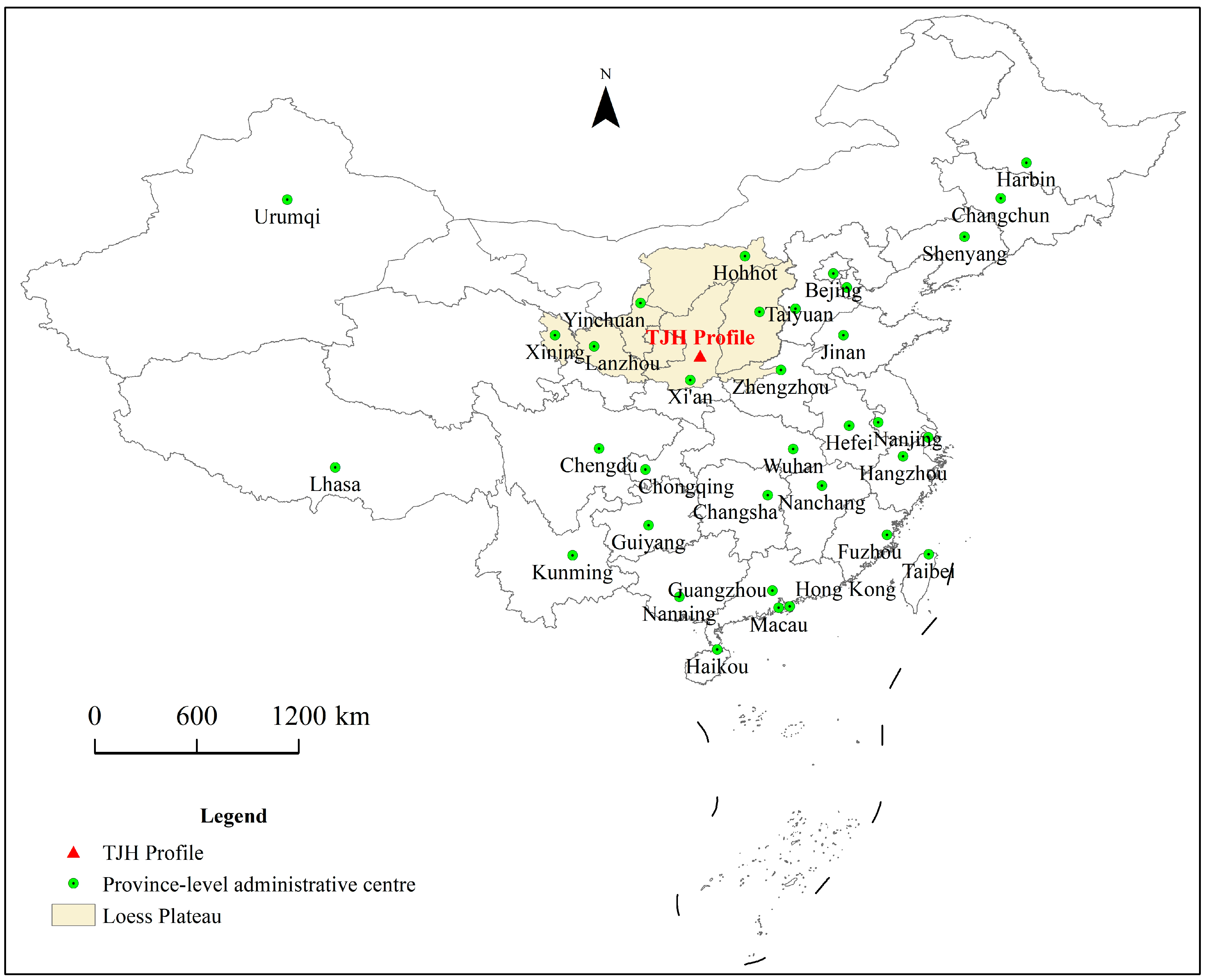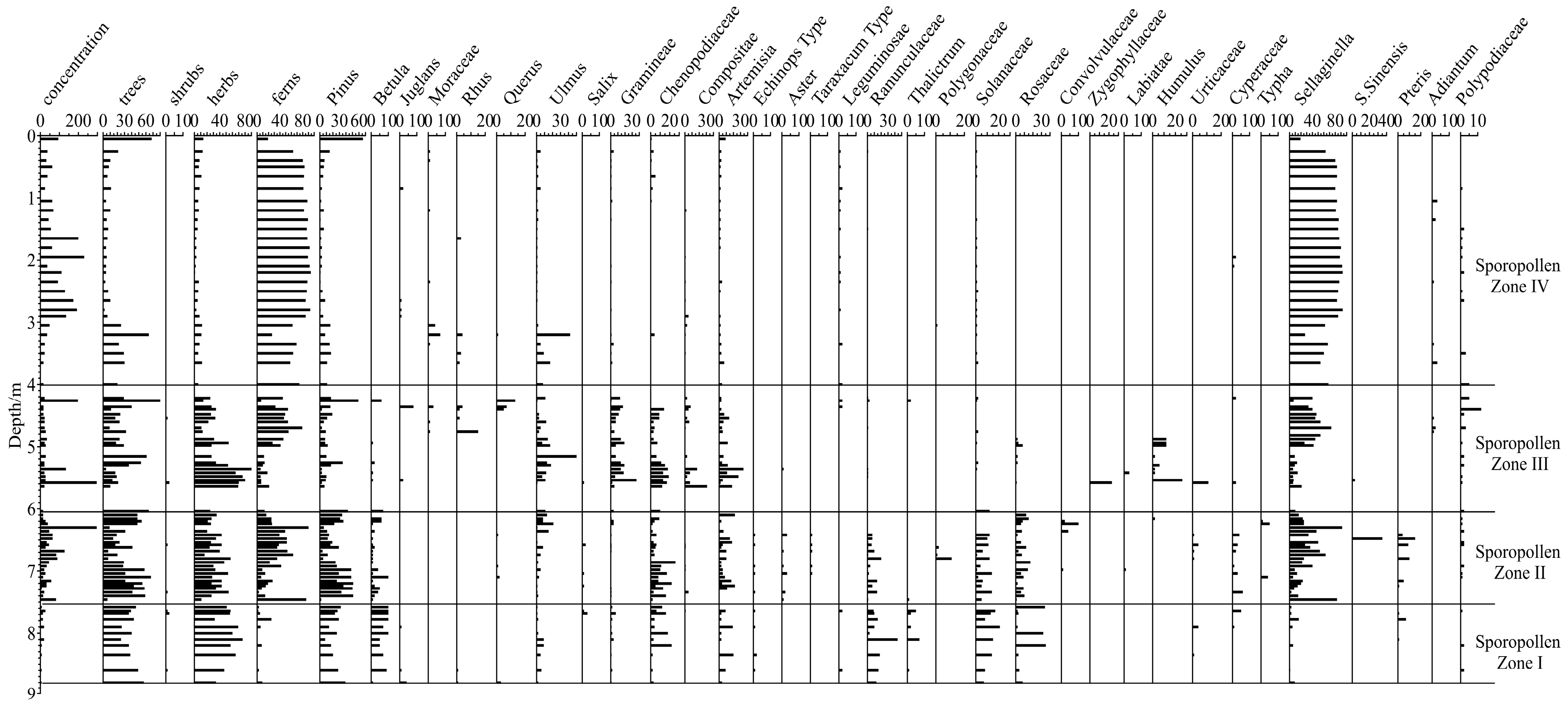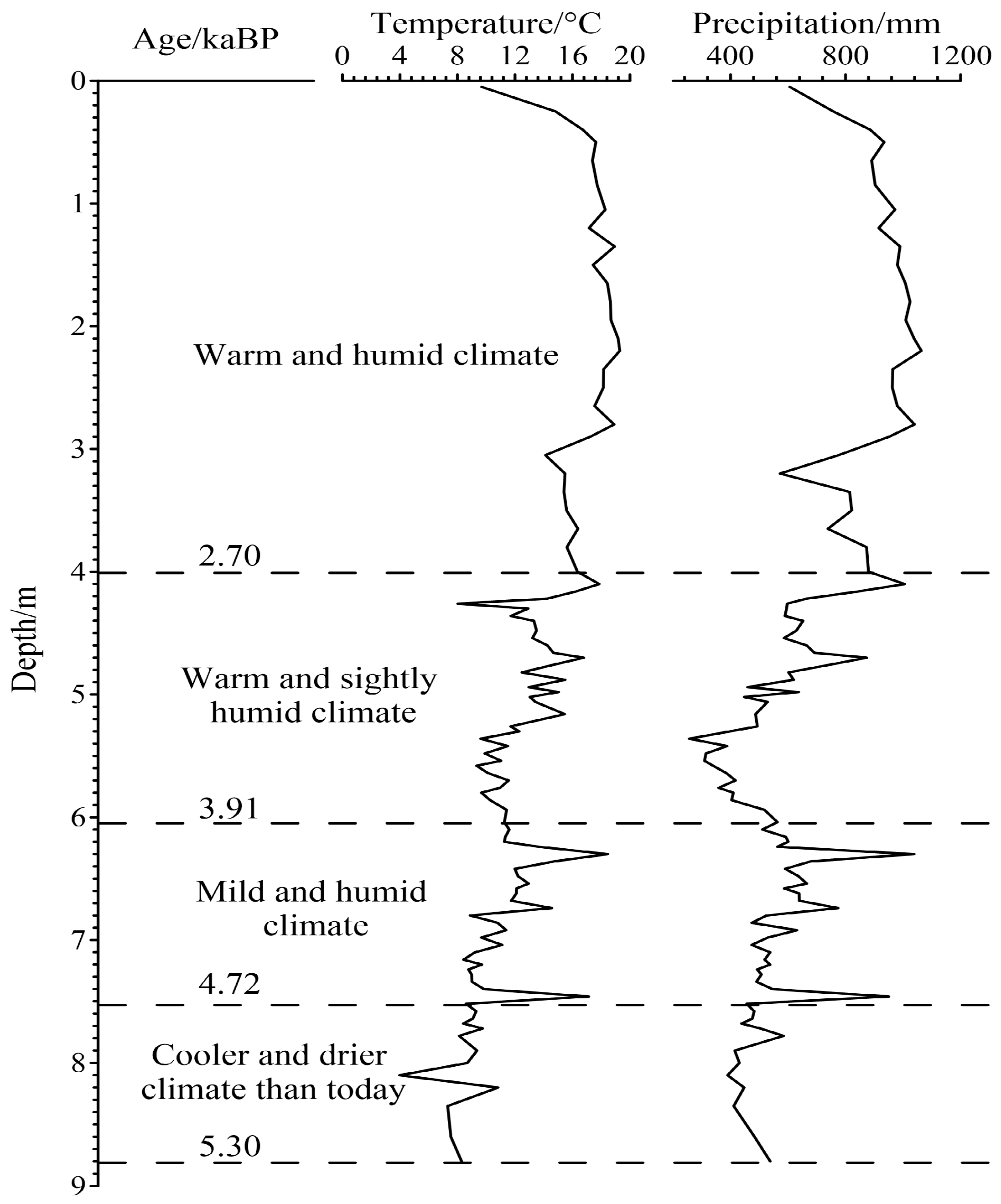The Quantitative Reconstruction of Paleoclimate in the Huangling Region of the Chinese Loess Plateau during the Middle and Late Holocene
Abstract
1. Introduction
2. Overview of the Study Area
- (1)
- Loess Unit L0-1
- (2)
- Paleosol Unit S0-1
- (3)
- Loess Unit L0-2
- (4)
- Paleosol Unit S0-2
- (5)
- Loess Unit L0-3
- (6)
- Paleosol Unit S0-3
- (7)
- Loess Unit L0-4
3. Materials and Methods
3.1. Spore–Pollen Analysis
3.2. Chronological Analysis
3.3. Statistical Methods
3.3.1. Cluster Analysis
3.3.2. Multiple Regression Analysis
3.3.3. Pollen–Climate Factor Conversion Function
4. Results
4.1. Characterization of Spore–Pollen Assemblages
4.2. Chronological Sequences
4.3. Results of the Quantitative Reconstruction of Paleoclimate
5. Discussion
6. Conclusions
Author Contributions
Funding
Institutional Review Board Statement
Informed Consent Statement
Data Availability Statement
Acknowledgments
Conflicts of Interest
References
- Zeng, F.M. Research progress on quantitative reconstruction of paleotemperature recorded in loess deposit since late Quaternary. Geol. Sci. Technol. Inf. 2013, 32, 84–88. [Google Scholar]
- Stocker, T.F.; Qin, D.H.; Plattner, G.K.; Tignor, M.M.B.; Allen, S.K.; Boschung, J.; Nauels, A.; Xia, Y.; Bex, V.; Midgley, P.M. Climate change 2013: The physical science basis. In Intergovernmental Panel on Climate Change, Working Group Ⅰ Contribution to the IPCC Fifth Assessment Report (AR5); Cambridge University Press: New York, NY, USA, 2013; p. 42. [Google Scholar]
- Liu, T.S. Loess and Environment; Science Press: Beijing, China, 1985. [Google Scholar]
- Burbank, D.W.; Li, J.J. Age and palaeoclimatic significance of the loess of Lanzhou, North China. Nature 1985, 316, 429–431. [Google Scholar] [CrossRef]
- Heller, F.; Liu, T.S. Magnetostratigraphical dating of loess deposits in China. Nature 1982, 300, 431–433. [Google Scholar] [CrossRef]
- An, Z.S.; Kutzbach, J.E.; Prell, W.L.; Porter, S.C. Evolution of Asian monsoons and phased uplift of the Himalaya-Tibetan plateau since Late Miocene times. Nature 2001, 411, 62–66. [Google Scholar] [CrossRef]
- Guo, Z.T.; Ruddiman, W.F.; Hao, Q.Z.; Wu, H.B.; Qiao, Y.S.; Zhu, R.X.; Peng, S.Z.; Wei, J.J.; Yuan, B.Y.; Liu, T.S. Onset of asian desertification by 22 Myr ago inferred from loess deposits in China. Nature 2002, 416, 159–163. [Google Scholar] [CrossRef] [PubMed]
- Han, J.M.; Lu, H.Y.; Wu, N.Q.; Guo, Z.T. The magnetic susceptibility of modern soils in China and its use for paleoclimate reconstruction. Stud. Geophys. Et Geod. 1996, 40, 262–275. [Google Scholar]
- Lv, H.Y.; Han, J.M.; Wu, N.Q.; Guo, Z.T. The magnetic susceptibility analysis of modern soil in China and its paleoclimatic significance. Sci. China (Ser. B) 1994, 24, 1290–1297. [Google Scholar]
- Song, Y.; Hao, Q.Z.; Ge, J.Y.; Zhao, D.A.; Zhang, Y.; Li, Q.; Zuo, X.X.; Lv, Y.W.; Wang, P. Quantitative relationships between modern soil magnetic susceptibility and climatic variables of the Chinese Loess Plateau. Quat. Sci. 2012, 32, 679–689. [Google Scholar] [CrossRef]
- Sun, X.J.; Song, C.Q.; Wang, F.Y.; Sun, M.R. Vegetation history of the Loess Plateau of China during the last 100,000 years based on pollen data. Quat. Int. 1997, 37, 25–36. [Google Scholar] [CrossRef]
- Lv, H.Y.; Wu, N.Q.; Liu, K.B.; Jiang, H.; Liu, T.S. Phytoliths as quantitative indicators for the reconstruction of past environmental conditions in China Ⅱ: Palaeoenvironmental reconstruction in the Loess Plateau. Quat. Sci. Rev. 2007, 26, 759–772. [Google Scholar] [CrossRef]
- Lv, H.Y.; Wu, N.Q.; Yang, X.D.; Jiang, H.; Liu, K.B.; Liu, T.S. Phytoliths as quantitative indicators for the reconstruction of past environmental conditions in China Ⅰ: Phytolith-based transfer functions. Quat. Sci. Rev. 2006, 25, 945–959. [Google Scholar]
- Zhang, Z.H.; Wei, M.J. Quantitative relationship between total iron oxide in loess and climate indicators. Chin. Sci. Bull. 1995, 40, 1219–1221. [Google Scholar] [CrossRef]
- Sun, J.M.; Diao, G.Y.; Wen, Q.Z.; Zhou, H.Y. A preliminary study on quantitative estimate of palaeoclimate by using geochemical transfer function in the Loess Plateau. Geochimica 1999, 28, 265–272. [Google Scholar] [CrossRef]
- Peterse, F.; Prins, M.A.; Beets, C.J.; Troeistra, S.R.; Zheng, H.B.; Gu, Z.Y.; Schouten, S.; Damsté, J.S.S. Decoupled warming and monsoon precipitation in East Asia over the last deglaciation. Earth Planet. Sci. Lett. 2011, 301, 256–264. [Google Scholar] [CrossRef]
- Gao, L.; Nie, J.S.; Clemens, S.; Liu, W.G.; Sun, J.M.; Zech, R.; Huang, Y.S. The importance of solar insolation on the temperature variations for the past 110 kyr on the Chinese Loess Plateau. Palaeogeogr. Palaeoclimatol. Palaeoecol. 2012, 317–318, 128–133. [Google Scholar] [CrossRef]
- Qin, F.; Zhao, Y. Methods of quantitative climate reconstruction based on palynological data and their applications in China. Quat. Sci. 2013, 33, 1054–1068. [Google Scholar] [CrossRef]
- Song, Y.G.; Yu, S.Y.; Zhu, C. Simulations of paleoclimate in the east China monsoon area since the last glaciation. Resour. Environ. Yangtze Basin 1998, 7, 260–265. [Google Scholar]
- Ren, L.Y.; Fu, J.H.; Lin, G.F.; Zhang, D.X. The application of sporo-pollen fossil information function for paleoenvironment analysis. J. Northwest Univ. (Nat. Sci. Ed.) 2001, 31, 506–508. [Google Scholar] [CrossRef]
- Yu, G.; Xiankun, K.E. Temperature sequence reconstruction by pollen data since the past 1ka in Canada. Sci. Bull. 2002, 47, 1018–1021. [Google Scholar] [CrossRef]
- Deng, Y.; Zheng, Z.; Cour, P.; Huang, C.X.; Duzer, D.; Calleja, M.; Roben, G.; Berne, S.; Vagnier, P. Relation between pollen ratios and climate in East China and an attempt of paleoclimate reconstruction. Acta Palaeontol. Sin. 2002, 41, 508–516. [Google Scholar] [CrossRef]
- Hughes, J.F.; Mathewes, R.W.; Clague, J.J. Use of pollen and vascular plants to estimate coseismic subsudence at a tidal marsh near Tofino, British Columbia. Palaeogeogr. Palaeoclimatol. Palaeoecol. 2002, 185, 145–161. [Google Scholar] [CrossRef]
- Tang, L.Y.; Shen, C.M.; Zhao, X.T.; Xiao, J.Y.; Yu, G.; Han, H.Y. Vegetation and climate since 10000aBP in the Qingfeng section, Jianhu, Jiangsu. Sci. China (Ser. B) 1993, 23, 637–643. [Google Scholar]
- Lu, J.J. Quantitative research of Late Quaternary paleoclimate factors in core No.1 in XiaPu, Fujian. J. Oceanogr. Taiwan Strait 1995, 14, 32–38. [Google Scholar]
- Liu, H.P.; Wang, K.F. A study on the relations between sporo-pollen assemblages and climate in new stone age of Changjiang delta by correspondence analysis. Sci. Geogr. Sin. 1998, 18, 368–373. [Google Scholar]
- Sun, X.J.; Wang, F.Y.; Song, C.Q. Pollen-climate response surface analysis of some families and genera in northern China. Sci. China (Ser. D) 1996, 26, 431–436. [Google Scholar]
- Markgraf, V.; Webb, R.S.; Anderson, K.H.; Anderson, L. Modern pollen/climate calibration for southern South America. Palaeogeogr. Palaeoclimatol. Palaeoecol. 2002, 181, 375–397. [Google Scholar] [CrossRef]
- Mosbrugger, V.; Utescher, T. The coexistence approach: A method for quantitative reconstruction of Tertiary terrestrial paleoclimate data using plant fossils. Palaeogeogr. Palaeoclimatol. Palaeoecol. 1997, 134, 61–86. [Google Scholar] [CrossRef]
- Hoorn, C.; Straathof, J.; Abels, H.A.; Xu, Y.D.; Utescher, T.; Dupont-Nivet, G. A late Eocene palynological record of climate change and Tibetan Plateau uplift (Xining Basin, China). Palaeogeogr. Palaeoclimatol. Palaeoecol. 2012, 344–345, 16–38. [Google Scholar] [CrossRef]
- Quan, C.; Liu, Y.S.; Utescher, T. Paleogene temperature gradient, seasonal variation and climate evolution of northeast China. Palaeogeogr. Palaeoclimatol. Palaeoecol. 2012, 313–314, 150–161. [Google Scholar] [CrossRef]
- Kay, P.A. Multivariate statistical estimates of Holocene vegetation and climate change, forest-tundra transition zone, NWT, Canada. Quat. Res. 1979, 11, 125–140. [Google Scholar] [CrossRef]
- Andrews, J.T.; Mode, W.N.; Davis, P.T. Holocene climate based on pollen transfer function, eastern Canadian Arctic. Arct. Alp. Res. 1980, 12, 41–64. [Google Scholar] [CrossRef]
- Adam, D.P.; West, G.J. Temperature and precipitation estimates through the last glacial cycle from Clear Lake, California, pollen data. Science 1983, 219, 168–170. [Google Scholar] [CrossRef] [PubMed]
- Seppä, H.; Birks, H.J.B. July mean temperature and annual precipitation trends during the Holocene in the Fennoscandian tree-line area: Pollen-based climate reconstructions. Holocene 2001, 11, 527–539. [Google Scholar] [CrossRef]
- Seppä, H.; Birks, H.J.B. Holocene climate reconstructions the Fennoscandian tree-line area based on pollen data from Toskljavri. Quat. Res. 2002, 57, 191–199. [Google Scholar] [CrossRef]
- Tong, G.B.; Shi, Y.; Wu, R.J.; Yang, X.D.; Qu, W.C. Vegetation and climatic quantitative reconstruction of Longgan Lake since the past 3000 years. Mar. Geol. Quat. Geol. 1997, 17, 53–61. [Google Scholar] [CrossRef]
- Tong, G.B.; Wu, X.H.; Tong, L.; Xiao, H.G. Spore-pollen records and tentative paleoclimate reconstruction in Taibai Mountain in the last 1000 years. J. Geomech. 1998, 4, 58–63. [Google Scholar]
- Tong, G.B.; Liu, Z.M.; Wang, S.M.; Yang, X.D.; Wang, S.B. Reconstruction of climate sequence of the past 1 Ma in the Heqing Basin, Yunnan province. Quat. Sci. 2002, 22, 332–339. [Google Scholar] [CrossRef]
- Song, C.Q.; Lv, H.Y.; Sun, X.J. Establishment and application of transfer function of pollen-climatic factors in northern China. Chin. Sci. Bull. 1997, 42, 2182–2186. [Google Scholar]
- Wang, F.Y.; Song, C.Q.; Cheng, Q.G.; Sun, X.J. Palaeoclimate reconstruction by adopting the pollen-climate response surface model to analysis the Chasuqi deposition section. Acta Bot. Sin. 1998, 40, 1067–1074. [Google Scholar]
- Xu, Q.H.; Xiao, J.L.; Nakamura, T.; Yang, X.L.; Yang, Z.J.; Liang, W.D.; Iuchi, B.; Yang, S.Y. Quantitative reconstructed climatic changes of Daihai Basin by pollen data. Mar. Geol. Quat. Geol. 2003, 23, 99–108. [Google Scholar]
- Xu, Q.H.; Yang, X.L.; Yang, Z.J.; Liang, W.D.; Sun, L.M. Reconstruction of climatic changes of Yansan Mountain area since 5000 aBP inferred from pollen data. Sci. Geogr. Sin. 2004, 24, 339–345. [Google Scholar]
- Cai, Y.L.; Chen, Z.Y.; Zhang, W.; Guo, Z.Y.; Chen, Y. Climate fluctuation of the western Shanghai district by correspondence analysis since 8.5kaB.P. J. Lake Sci. 2001, 13, 118–124. [Google Scholar] [CrossRef][Green Version]
- Wu, J.H.; Zhang, S.; Jiang, Y.; Kang, M.Y.; Qiu, Y. Plant Geography; Higher Education Press: Beijing, China, 2004. [Google Scholar]
- Chen, Y.G. Geography Mathematical Methods: Fundamentals and Applications; Science Press: Beijing, China, 2011. [Google Scholar]
- Wang, S.G.; Chen, M.; Chen, L.P. Linear Statistical Models—Linear Regression and Analysis of Variance; Higher Education Press: Beijing, China, 2002. [Google Scholar]
- Yuan, Z.F.; Guo, M.C.; Song, S.D.; Xie, X.L.; Liu, J.J.; Du, J.L.; Dong, X.M. Multivariate Statistical Analysis, 3rd ed.; Science Press: Beijing, China, 2018. [Google Scholar]
- Zhang, J. Study on Modern Surface Pollen-Climatic Factors Transfer Function in Partial Region of the Northwest China. Master’s Thesis, Lanzhou University, Lanzhou, China, 2004. [Google Scholar]
- Li, J.Y.; Ilvonen, L.; Xu, Q.H.; Ni, J.; Jin, L.Y.; Holmstrom, L.; Zheng, Z.; Lv, H.Y.; Luo, Y.L.; Li, Y.C. East Asian summer monsoon precipitation variations in China over the last 9500 years: A comparison of pollen-based reconstructions and model simulations. Holocene 2015, 26, 592–602. [Google Scholar] [CrossRef]
- Tian, F.; Herzschuh, U.; Telford, R.J.; Mischke, S.; Meeren, T.V.; Krengel, M. A modern pollen-climate calibration set from central-western Mongolia and its application to a Late Glacial-Holocene record. J. Biogeogr. 2014, 41, 1909–1922. [Google Scholar] [CrossRef]
- Zheng, Z.; Zhang, X.; Man, M.L.; Wei, J.H.; Huang, K.Y. Review and data integration of pollen-based quantitative paleoclimate reconstruction studies in China and adjacent areas. Quat. Sci. 2016, 36, 503–519. [Google Scholar] [CrossRef]
- Webb, T.; Bryson, R.A. Late and postglacial climate change in the Northern Midwest, USA: Quantitative estimates derived from fossil pollen spectra by multivariate statistic analysis. Quat. Res. 1972, 2, 70–115. [Google Scholar] [CrossRef]
- Berger, A.L. Long term variations of caloric insolation resulting from the Earth’s orbital elements. Quat. Res. 1978, 9, 139–167. [Google Scholar] [CrossRef]
- Yu, K.F.; Lu, H.Y.; Frank, L.; Veit, N. A preliminary quantitative paleoclimate reconstruction of the dune fields of northern China during the Last Glacial Maximum and Holocene Optimum. Quat. Sci. 2013, 33, 293–302. [Google Scholar] [CrossRef]
- Kaufman, D.; Mckay, N.; Routson, C.; Erb, M.; Davis, B.; Heiri, O.; Jaccard, S.; Tierney, J.; Dätwyler, C.; Axford, Y.; et al. A global database of Holocene paleotemperature records. Sci. Data 2020, 7, 115. [Google Scholar] [CrossRef]
- Sun, Y.B.; Lu, H.X.; Zhang, Z.K. New progress in quantitative reconstruction of paleoclimate changes in the Chinese Loess Plateau. Acta Geol. Sin. 2024, 98, 1–19. [Google Scholar] [CrossRef]
- Gao, X.B.; Hao, Q.Z.; Wang, L.; Frank, O.; Jan, B.; Deng, C.L.; Song, Y.; Ge, J.Y.; Wu, H.B.; Xu, B.; et al. The different climatic response of pedogenic hematite and ferrimagnetic minerals: Evidence from particle-sized modern soils over the Chinese Loess Plateau. Quat. Sci. Rev. 2018, 179, 69–86. [Google Scholar] [CrossRef]
- Ning, Y.F.; Liu, W.G.; An, Z.S. A 130-ka reconstruction of precipitation on the Chinese Loess Plateau from organic carbon isotopes. Palaeogeogr. Palaeoclimatol. Palaeoecol. 2008, 270, 59–63. [Google Scholar] [CrossRef]
- Li, T.; Liu, F.; Abels, H.A.; You, C.F.; Zhang, Z.K.; Chen, J.; Li, J.F.; Li, L.F.; Li, L.; Liu, H.C.; et al. Continued obliquity pacing of East Asian summer precipitation after the mid-Pleistocene transition. Earth Planet. Sci. Lett. 2017, 457, 181–190. [Google Scholar] [CrossRef]
- Ma, L.; Sun, Y.B.; Jin, Z.D.; Bao, Z.A.; Zhang, P.; Meng, Z.K.; Yuan, H.L.; Long, X.P.; He, M.Y.; Huang, K.J. Tracing changes in monsoonal precipitation using Mg isotopes in Chinese loess deposits. Geochim. Cosmochim. Acta 2019, 259, 1–16. [Google Scholar] [CrossRef]
- Beck, J.W.; Zhou, W.J.; Li, C.; Wu, Z.K.; White, L.; Xian, F.; Kong, X.H.; An, Z.S. A 550000-year record of East Asian monsoon rainfall from 10Be in loess. Science 2018, 360, 877–881. [Google Scholar] [CrossRef] [PubMed]
- Hao, Q.Z.; Guo, Z.T. Quantitative study on weathering soil formation intensity of loess-paleosol sequence since 1.2 Ma and evolution of east Asian summer monsoon. Sci. China (Ser. D) 2001, 31, 520–528. [Google Scholar]
- Tang, L.Y.; An, C.B. Pollen records of vegetation changes and drought events in the Holocene on the Loess Plateau of central Gansu. Prog. Nat. Sci. 2007, 17, 1371–1382. [Google Scholar]
- Bao, R.; Sheng, X.F.; Lu, H.Y.; Li, C.L.; Luo, L.; Shen, H.; Wu, M.; Ji, J.F.; Chen, J. Stable carbon and oxygen isotopic composition of modern land snails along a precipitation gradient in the mid-latitude East Asian monsoon region of China. Palaeogeogr. Palaeoclimatol. Palaeoecol. 2019, 533, 109236. [Google Scholar] [CrossRef]
- Wang, H.Y.; An, Z.S.; Lu, H.X.; Zhao, Z.H.; Liu, W.G. Calibrating bacterial tetraether distributions towards in situ soil temperature and application to a loess-paleosol sequence. Quat. Sci. Rev. 2020, 231, 106172. [Google Scholar] [CrossRef]
- Li, J.H. Holocene Climate Change Documented by Loess Biomarkers in the Southern Loess Plateau. Master’s Thesis, Northwest University, Xi’an, China, 2022. [Google Scholar]
- Wang, F. Research of Structural Geology and Genesis of Pollen Assemblages and Paleoenvironment Since Holocene in the Weinan Region. Master’s Thesis, Shijiazhuang University of Economics, Shijiazhuang, China, 2015. [Google Scholar]




Disclaimer/Publisher’s Note: The statements, opinions and data contained in all publications are solely those of the individual author(s) and contributor(s) and not of MDPI and/or the editor(s). MDPI and/or the editor(s) disclaim responsibility for any injury to people or property resulting from any ideas, methods, instructions or products referred to in the content. |
© 2024 by the authors. Licensee MDPI, Basel, Switzerland. This article is an open access article distributed under the terms and conditions of the Creative Commons Attribution (CC BY) license (https://creativecommons.org/licenses/by/4.0/).
Share and Cite
Guo, J.; Shi, J.; Dong, Q.; Song, C.; Chen, H.; Wang, W. The Quantitative Reconstruction of Paleoclimate in the Huangling Region of the Chinese Loess Plateau during the Middle and Late Holocene. Atmosphere 2024, 15, 476. https://doi.org/10.3390/atmos15040476
Guo J, Shi J, Dong Q, Song C, Chen H, Wang W. The Quantitative Reconstruction of Paleoclimate in the Huangling Region of the Chinese Loess Plateau during the Middle and Late Holocene. Atmosphere. 2024; 15(4):476. https://doi.org/10.3390/atmos15040476
Chicago/Turabian StyleGuo, Jiao, Jiansheng Shi, Qiuyao Dong, Chao Song, Hongyun Chen, and Wei Wang. 2024. "The Quantitative Reconstruction of Paleoclimate in the Huangling Region of the Chinese Loess Plateau during the Middle and Late Holocene" Atmosphere 15, no. 4: 476. https://doi.org/10.3390/atmos15040476
APA StyleGuo, J., Shi, J., Dong, Q., Song, C., Chen, H., & Wang, W. (2024). The Quantitative Reconstruction of Paleoclimate in the Huangling Region of the Chinese Loess Plateau during the Middle and Late Holocene. Atmosphere, 15(4), 476. https://doi.org/10.3390/atmos15040476




